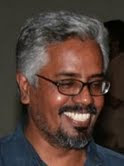Elephantine Celebrations
Of Elephants and Malayalee Celebrations
Elephants are an ubiquitous presence for the central keralites during the 'festival season stretching from November to April (starting from festival at Tripunithura Temple to the one at Koodalmanikkam, Irinjalakuda). During this season, one comes across elephants everywhere; on the road, trudging their tedious way through the burning macadem roads, making a very precarious journey atop trucks, and at festivals, carrying the image of god and His or Her henchmen with all kinds of paraphernalia, in front of the teeming population of festival celebrators, percussionists and the huge multi-pronged torches blazing in front of them. Flex boards with huge pictures of elephants abound by the roadside announcing the impending festivals, and also the contribution-seekers in advance. Such demand for elephants is a recent phenomenon, with every temple vying with each other to field as many of them as possible in their festivals; every festival in central Kerala wants to be a Trichur Pooram, thus erasing their difference, local identity and colour. Every festival looks the same now, with the very same 'ezhunnallippus', paraphernalia and even the same percussionists and programmes. Everywhere it becomes a spectacle imported from outside, a copy of something grand, always yearning to be something it is not.
Elephants are a very popular stuff of local folklore and mythology from time immemorial. Kottarathil Sankunni wrote a series about the legendary 'kombans' in his 'Aithihyamala' bringing to life myths about elephants for generations to come. One of the popular non-story serials in Malayalam television now is about elephants (E for Elephant). There are a number of books being still written about legendary elephants (recent one being, 'Paramekkavu Parameswaran' by C A Menon). Films have also been made with elephant as the central character (like Guruvayur Kesavan). Above all, the elephant is supposed to constitute the typical symbol and embody the culture and tradition of the malayalees (whether it be the logo of the state government, its agencies, or our tourism promos).
For all this love for this majestic pachyderm, are we really kind to them? Do we have the right to parade them for endless hours for our pleasure? Do we really care for them at all? These are the questions that the heart-wrenching documentary of P Balan (18 th Elephant – Three Monologues) tries to raise. Structured as a series of monologues and with constant reminders about various such species similarly extinct, the film delves into the way elephants are actually treated by us. The goriness of some of the sequences in the film may be extremely painful to watch, but the emotional and intellectual impact these searing visuals have on the viewer is undeniable. The film virtually tears apart the façade of our much celebrated love for these poor beings, something that also throw curious light upon the contradictions of malayalee life and attitudes. We parade them with golden accoutrements in our festivals, but employ them for the most tedious of tasks. The film in fact looks behind the façade and into their lives beyond the 'ezhunnallippus' and into the dark realms of their real life (ours and that of these poor beasts) beyond the 'festive visibility' of our festivities.
18th Elephant – Three Monologues is a film that every elephant-lover in Kerala should necessarily see.


0 Comments:
Post a Comment
Subscribe to Post Comments [Atom]
<< Home